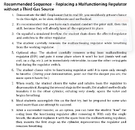However, here are some cons I see in sidemount:
1. increases task loading the first few times you dive it with the constant gas switching. Someone learning how to cave dive is already tasked loaded enough, and really doesn't need the extra bit of task loading involved with learning sidemount at the same time.
Task loading is increased in any unfamiliar equipment. The same is true for a diver first transitioning to backmounted doubles from a jacket BCD.
IMHO, beginning technical / cave divers are better served diving backmount, OR mastering sidemount before undertaking technical training.
I agree wholeheartedly. The diver should be well experienced in their configuration before adding further stressors in an overhead environment.
Luckily, you can do stand-alone sidemount courses and spend ample time diving sidemount on all of your recreational dives... potentially years in advance of reaching overhead diving levels.
Backmount doubles are much harder to source training for - unless in conjunction with a entry-level level course. Yes, there is 'intro-do-doubles' training, but this is harder to source and, often, not an agency sanctioned certification course.
With basic sidemount training, you can literally do ALL of your subsequent dives on sidemount - amassing significant kit experience and familiarity. That's not so common with backmount doubles.
2. Is less efficient. When I dive backmount I can be suited up and in the water in a fraction of the time it takes when diving sidemount (how many trips do you make to the water?). Ditto for breaking gear down.
Personally, I think that's just an equipment familiarity and/or procedural issue.
I never have a problem being first in the water by a margin. When it comes to getting back on the boat - I'm normally drinking a coffee whilst backmount divers are still struggling to remove weight-belts chin-deep...
Regards 'trips to the water'... sidemount gives the option to 'spread the load' over multiple trips. That doesn't, however, mean you are forced to multiple trips.
3. Is frequently taught in a sloppy style that leads to damage to caves. Ever notice those twin furrow trails in clay floors? Look at the antenna that are sticking out from under your armpits to understand how they happened.
Bad instruction causes bad divers causes bad consequences.
Bad instructors wear poodle jackets, backmount doubles and sidemount. So do good instructors.
But these are just my opinion, and while I think newer technical / cave divers will be better served by learning backmount first...
If a diver will progress into technical/overhead diving, then they are best served by 'beginning with the end in mind'... making the earliest possible transition into the kit
they plan to use in the future.
I see little efficiency in transitioning from jacket to BP&W doubles.... then later transitioning
again into sidemount. That's two transitions, rather than one.
It also means that the diver is denied an earliest opportunity to begin developing intimate familiarity with the kit... and forces them to subsequently manage a transition into unfamiliar kit when they are already diving at a technical/overhead level.
Where do you guys are getting this from? Does anyone actually teach this or is this from some youtube video?
From a certain agencies' technical sidemount instructor manual....


How about purging the regs before breathing them? I'm sure that would blow all the crud right out. And as you may know, it also helps to exhale before breathing.
If in doubt, you can do both. Or you could choose to delay the gas switch altogether.
Either way, a non issue.
It's a non issue simply because moving through POL (petrol/oil/lubricant) contaminated water is going to have a major impact on your breathing equipment - whether it's in your mouth or not.
The last time I experienced this was in backmount. The wreck had burped some diesel. My regulator wasn't removed from my mouth for the duration. The reek of diesel still made me gag and wretch for the remainder of the dive.
It permeated everything. The primary was as badly contaminated as the secondary... and took just as much cleaning/servicing/maintenance to resolve as the (
unbreathed/exposed) secondary did. My mask was a written off - stinking and discolored. Everything else stunk like a gas station forecourt for months afterwards.
Kev used this spurious example through allegiance to an otherwise hard to justify sidemount equipment solution. It shows two things: Firstly, he's short of ways to defend a ludicrous sidemount manifold gimmick; and secondly, he's hypothesizing and has never personally experienced POL contamination inside a wreck.





